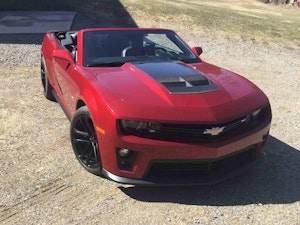Media | Articles
The First Flakes Have Fallen: It’s Time for Winter Storage Preparation
For many, the first snow of the winter has already fallen, and winterizing the beloved collector vehicle has suddenly become top on the priority list. If the car is simply parked in the garage for an extended period of time without preparation, you may return to a dead battery or — even worse — a damaged engine, flattened tires, or electrical or interior damage from rodents. The following steps will prevent any springtime heartbreak:
Wash and Wax – It may seem fruitless to wash the car when it is about to be put away for months, but it is an easy step that shouldn’t be overlooked. Water stains or bird droppings left on the car can permanently damage the paint. Make sure to clean the wheels and undersides of the fenders to get rid of mud, grease and tar. For added protection, give the car a coat of wax and treat any interior leather with a good conditioner.
Car Covers – Even though your classic is stored in the garage in semi-stable temperatures and protected from the elements, a weatherproof car cover will keep any spills or dust off of the paint. It can also protect from scratches while moving objects around the parked car.
Oil Change – If you will be storing the vehicle for longer than 30 days, consider getting the oil changed. Used engine oil has contaminants that could damage the engine or lead to sludge buildup.
Fuel Tank – Before long-term storage of over 30-days, remember to fill the gas tank to prevent moisture from accumulating inside the fuel tank and to keep the seals from drying out. You should also purchase a fuel stabilizer to prevent ethanol buildup and protect the engine from gum, varnish and rust. The fuel stabilizer will prevent the gas from deteriorating for up to 12 months.
Marketplace
Buy and sell classics with confidence
Battery Care – An unattended battery will eventually lose its charge, resulting in having to purchase a new battery in the spring. The easiest, low-tech solution is to disconnect the battery cables — the negative (ground) first, then the positive. You’ll likely lose any stereo presets, time and other settings. If you want to keep those settings and ensure that your battery starts the moment you return, purchase a battery tender, also known as a trickle charger. This device hooks up to your car battery on one end, then plugs into a wall outlet on the other and delivers just enough electrical power to prevent the battery from dying.
Parking Brake Tips – For general use it is a good idea to use the parking brake, but don’t do it when you leave a car in storage long term; if the brake pads make contact with the rotors for an extended period of time, they could fuse together. Instead of risking your emergency brake, purchase a tire stopper or two — also called a chock — to prevent the car from moving.
Tire Care – If a vehicle is left stationary for too long, the tires could develop flat spots from weight of the vehicle pressing down on the tires’ treads. This occurs at a faster rate in colder temperatures, especially with high-performance or low-profile tires and in severe cases, a flat spot becomes a permanent part of the tire causing a need for replacement. If your car will be in storage for more than 30 days, consider taking the wheels off and placing the car on jack stands at all four corners. This step requires more work than simply inflating the tires to the recommended pressure, but it can save you the disappointment that a set of destroyed tires would cause.
Repel Rodents – A solid garage will keep your car dry and relatively warm, conditions that can also attract unwanted rodents during the cold winter months. There are plenty of places in your car for critters to hide and even more things for them to destroy. Prevent them from entering your car by covering any gaps where a mouse could enter, such as the exhaust pipe or an air intake; steel wool works well for this. Next, spread mothballs or cotton swabs dipped in peppermint oil along the perimeter of the vehicle as a rodent repellent. Instead of stinky mothballs, a product called Fresh Cab has been a part of my personal success in keeping the rodents away. For a more proactive approach in conjunction to the prior suggestions, lay down a few mousetraps, but make sure someone can check the garage regularly for casualties or you will have to deal with a smell much worse than mothballs.
Maintain Insurance – You might be tempted to cancel your auto insurance when your vehicle is in storage in order to save money. If you remove coverage completely, it would be a major loss if a fire started, the weight of snow causes your roof to collapse, or if a theft occurred. Even if just collision coverage is temporarily removed, the car would not be covered when another moving object (for example: a tractor or motorcycle) rolled into it, or if the car were to fall of its jack stands. If you have classic car insurance, namely with Hagerty, the policy covers a full year and takes winter storage into account in your annual premium, so you don’t have to worry about your car over the winter months.










